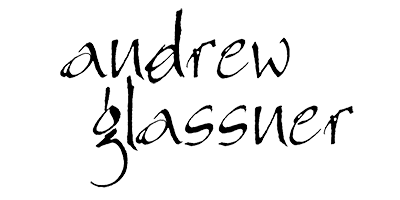Clock Faces
I’ve been designing clock faces since I was a kid. The problem of creating an attractive, legible, and original clock face is very appealing to me. Working with the standard circular face and two (or three) hands, this is a very constrained problem. Yet I’ve felt it was ripe for creative design and variation.
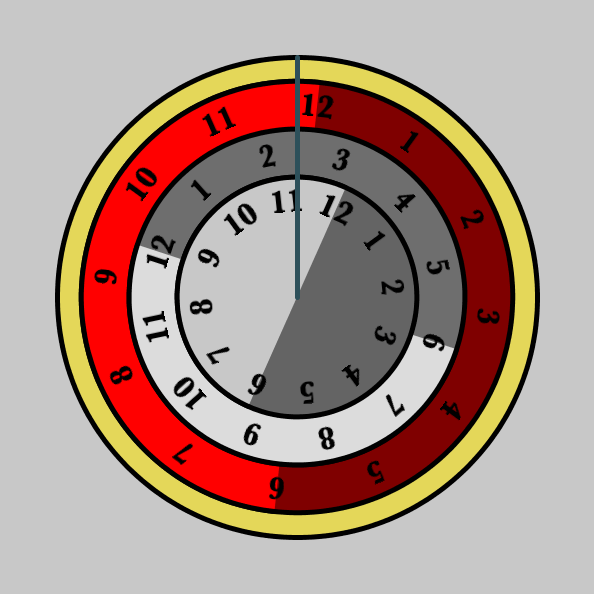 A great way to see new designs in action, and easily modify them, is to make them first on the computer. I’ve written programs to render my clock designs on almost every computer I’ve ever owned, from my original 128k black-and-white Mac, to my TiVo, to my iPhone. Here’s a simple starting point: the “hands” are the gray line running from the center of the design to the top. In this design, the hands stay still, while the clock face rotates under them. The innermost ring reports the hours, the middle ring the minutes, and the outer ring the seconds. In this snapshot, it’s about 11:22:59.
A great way to see new designs in action, and easily modify them, is to make them first on the computer. I’ve written programs to render my clock designs on almost every computer I’ve ever owned, from my original 128k black-and-white Mac, to my TiVo, to my iPhone. Here’s a simple starting point: the “hands” are the gray line running from the center of the design to the top. In this design, the hands stay still, while the clock face rotates under them. The innermost ring reports the hours, the middle ring the minutes, and the outer ring the seconds. In this snapshot, it’s about 11:22:59.
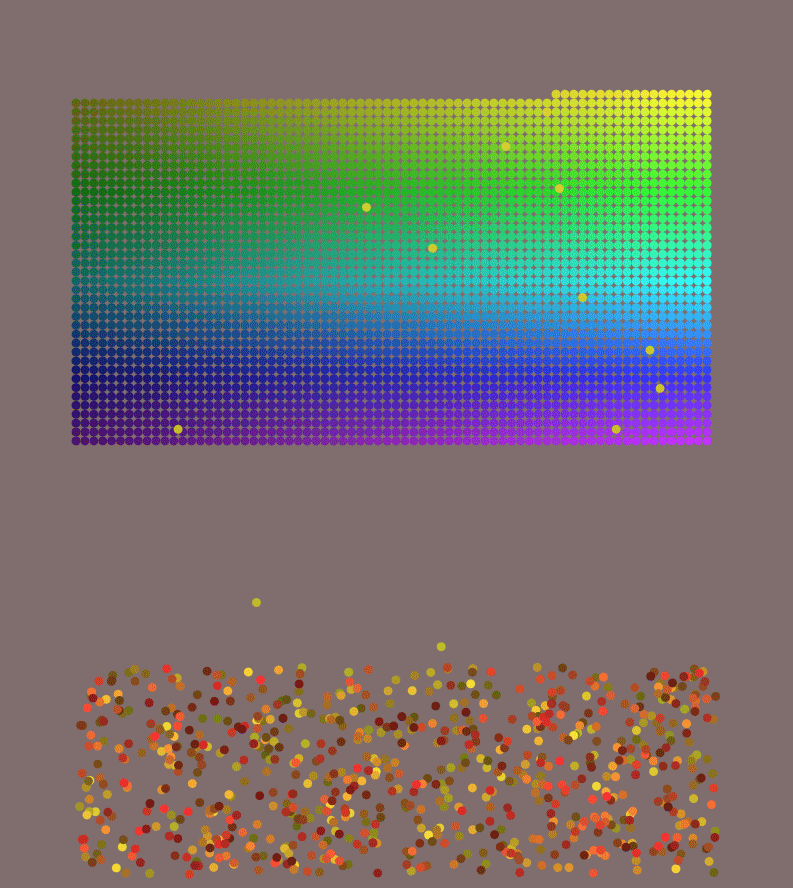 Of course, clocks can be much more abstract. This is an example of a one-hour clock, based on the same idea as an hourglass. At the start of each hour, a grid of 3600 dots appears at the top of the screen: this gives us one dot for each second in the hour. The dots are multicolored to add some visual interest. Over time, the dots fall, starting in the upper-left and working right and down. The dots fall, of course, at a rate of one per second. But it takes each dot a few seconds to drift to the lower part of the screen, following a curvy, meandering path. Here we can see 10 or 11 dots in motion. The dots end up at the bottom of the screen in a jumble. At the end of the hour, the dots fly back up into formation, and the process starts over again. This isn’t meant for telling the time exactly, but for just getting a visual estimate. You can eyeball how much of the grid is gone, or how many dots are at the bottom, or both, and work out about how far into the hour you are.
Of course, clocks can be much more abstract. This is an example of a one-hour clock, based on the same idea as an hourglass. At the start of each hour, a grid of 3600 dots appears at the top of the screen: this gives us one dot for each second in the hour. The dots are multicolored to add some visual interest. Over time, the dots fall, starting in the upper-left and working right and down. The dots fall, of course, at a rate of one per second. But it takes each dot a few seconds to drift to the lower part of the screen, following a curvy, meandering path. Here we can see 10 or 11 dots in motion. The dots end up at the bottom of the screen in a jumble. At the end of the hour, the dots fly back up into formation, and the process starts over again. This isn’t meant for telling the time exactly, but for just getting a visual estimate. You can eyeball how much of the grid is gone, or how many dots are at the bottom, or both, and work out about how far into the hour you are.
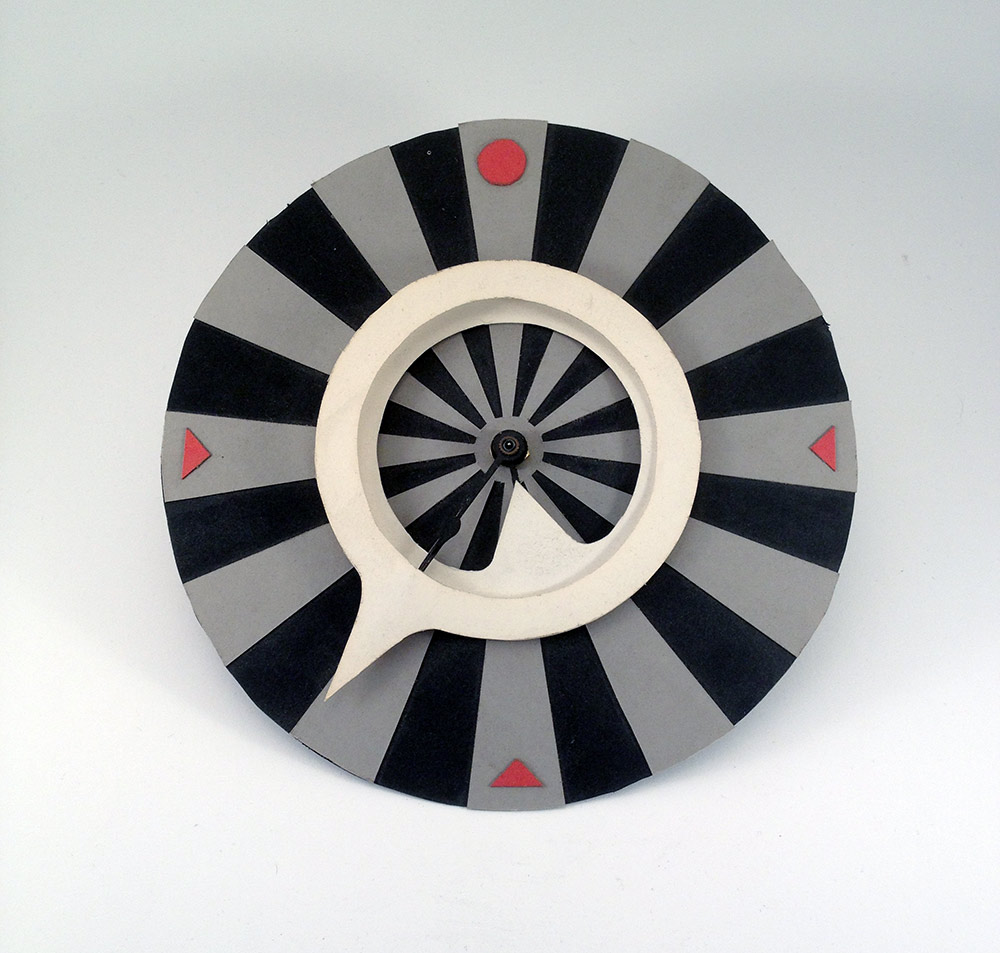 Of the hundreds (or thousands) of clock faces I’ve designed, I’ve probably actually made about two dozen of them. I usually start with a battery-driven quartz mechanism. This is a little block of black plastic with a slot for a AA battery, and it forms the drive for almost every wall clock made today. I cut my clock parts out of colored card or sheets of colored foam. The trickiest part is usually getting the new hands to connect up properly with the two little cylinders exposed by the quartz mechanism. Without getting into elaborate construction techniques, I usually need to compromise a little. In this clock, the idea is that the outer minute hand points out, while the inner minute hand points in. Ideally, you wouldn’t perceive them as two separate planes: it would be a single white band with two curved, pointy bits (if you squint you may be able to make them combine in this way). In practice, I used two white pieces, each attached to a hand mounted in the traditional way. The costs of making this clock in real life are that you can see a shadow between the two white pieces, and you can also see the thin, black hands.
Of the hundreds (or thousands) of clock faces I’ve designed, I’ve probably actually made about two dozen of them. I usually start with a battery-driven quartz mechanism. This is a little block of black plastic with a slot for a AA battery, and it forms the drive for almost every wall clock made today. I cut my clock parts out of colored card or sheets of colored foam. The trickiest part is usually getting the new hands to connect up properly with the two little cylinders exposed by the quartz mechanism. Without getting into elaborate construction techniques, I usually need to compromise a little. In this clock, the idea is that the outer minute hand points out, while the inner minute hand points in. Ideally, you wouldn’t perceive them as two separate planes: it would be a single white band with two curved, pointy bits (if you squint you may be able to make them combine in this way). In practice, I used two white pieces, each attached to a hand mounted in the traditional way. The costs of making this clock in real life are that you can see a shadow between the two white pieces, and you can also see the thin, black hands.
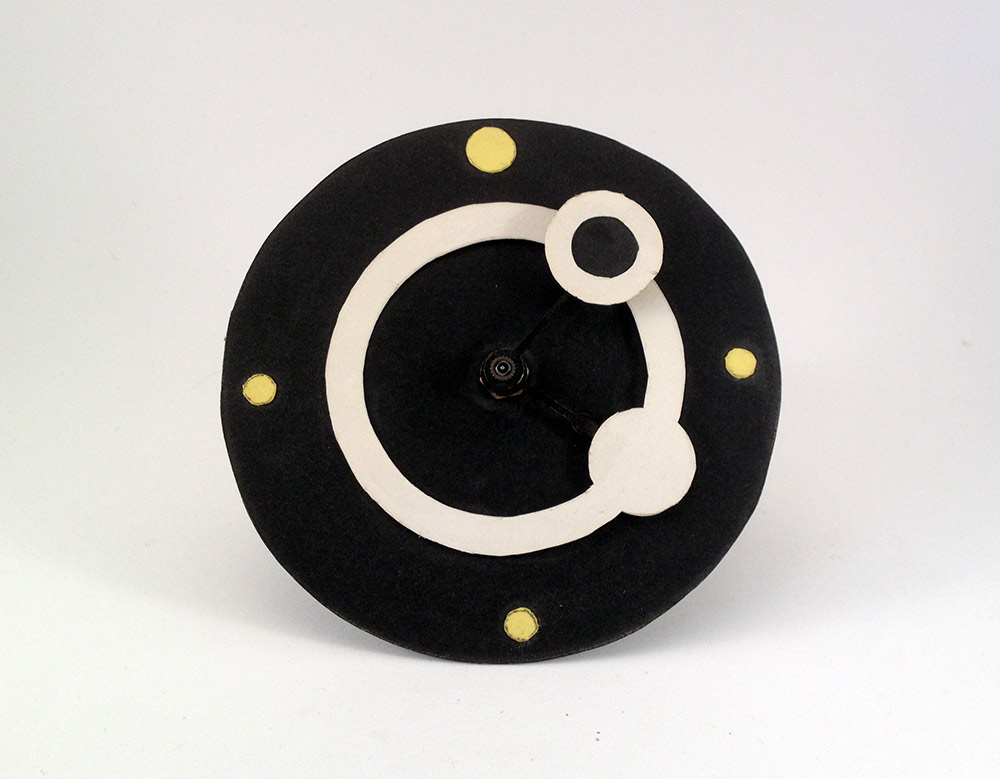 I like the simplicity of this design. The black center hides the black hands. The solid white disk indicates the hour, while the small white ring with a center of black indicates the minute. As before, I’d originally intended for the minute shape to be so close to the hour ring that it appeared to be of the same piece. In practice, it’s easy to see that they’re on different pieces. But this time the physical compromise worked out in my favor, because I like seeing the minute hand floating over the hour hand like this. Note that the topmost yellow circle is larger than the others: this is 12 o’clock, so you hang the clock with this circle at the top.
I like the simplicity of this design. The black center hides the black hands. The solid white disk indicates the hour, while the small white ring with a center of black indicates the minute. As before, I’d originally intended for the minute shape to be so close to the hour ring that it appeared to be of the same piece. In practice, it’s easy to see that they’re on different pieces. But this time the physical compromise worked out in my favor, because I like seeing the minute hand floating over the hour hand like this. Note that the topmost yellow circle is larger than the others: this is 12 o’clock, so you hang the clock with this circle at the top.
I’ve got a huge number of clock faces in my archives, and I’m always adding to them. Some clocks really can’t be made out of physical materials, and they’re perfect candidates for computer implementation. If the day comes when we’re all wearing high-resolution displays on our wrists, I’ll be able to bring all my clock faces to life for daily use. But as much as I love digital implementations, they don’t carry quite the same reward that comes from making a real, physical clock, hanging it on the wall, and using it to tell time.
